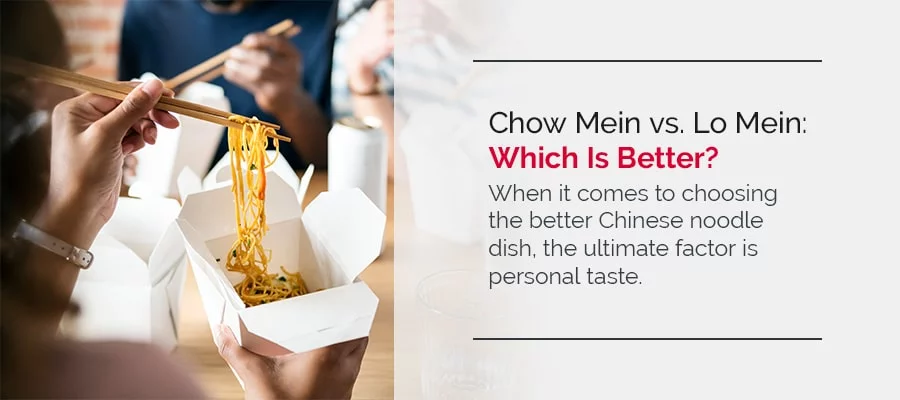How to Make Lo Mein
While it uses a slightly different cooking method, lo mein has all the same advantages as chow mein, including versatility, a straightforward sauce, quick and simple cooking, and hidden veggies. For lo mein, noodles are not fried. Rather, thoroughly cooked egg noodles are combined with protein and stir-fried veggies. Additionally, lo mein has a ton of sauce on it to coat the plump, soft noodles.
The ingredients for the lo mein noodles you’ll need to have on hand are listed below before we get into the specifics of cooking this tasty dish:
- Noodles: For the best results, use fresh egg noodles. You can make your lo mein with almost any other kind of long noodle if you’re in a hurry.
- Vegetables: Heartier vegetables like broccoli, bell peppers, sliced zucchini, and carrots are often used in lo mein. For an additional taste boost, you can also add some chopped onion, green onion, and garlic.
- Protein: Nearly any protein goes well with lo mein. Lo mein typically contains tofu, shrimp, turkey, beef, or pork.
- Ingredients for the sauce: Sesame oil, light and dark soy sauces, ginger and garlic, oyster sauce, and a small amount of sugar are the main ingredients of lo mein sauce. Add some red pepper flakes to your noodles if you like them a little spicy.
To create the ideal lo mein, put your ingredients in order and then follow these instructions:
- Boil and drain the egg noodles.
- To make your Lo Mein Sauce, whisk together all the ingredients.
- Add the protein and vegetables to a hot wok or heavy-based skillet and stir-fry. To further season the vegetables and protein while they’re cooking, stir in a small amount of the lo mein sauce. Just cook the vegetables until the outside is lightly browned and the center is still slightly raw. If the vegetables are overcooked, water will seep out and dilute the flavor of the sauce.
- Add the noodles and sauce to the wok.
- Toss the noodles with the sauce and other ingredients using two wooden spoons. Stir frequently and quickly to prevent the noodles from getting too soft, watery, or overdone.
- As soon as the noodles are coated, remove from the wok, plate, and enjoy!
The sauce is what sets apart any lo mein dish, so make sure you take your time and get it just right. Light soy sauce adds extra flavor and saltiness to the dish without discoloring the noodles, while dark soy sauce gives the lo mein color and a bolder taste. Use Tamari, which employs more soy protein to produce a richer, more nuanced flavor, for a stronger, more savory flavor.
Compared to chow mein, this dish will have far more sauce because the sauce is the main ingredient. By soaking up the sauce, the thick and chewy fresh egg noodles perfectly complement the lo mein sauce. These plump, soft noodles are perfect for lo mein because they can be wrapped around chopsticks.
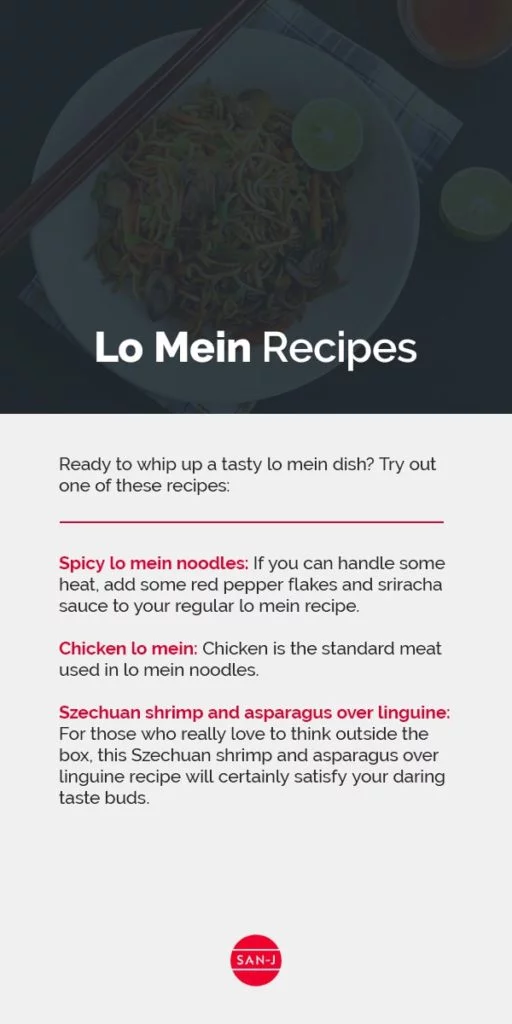
Interested in making a delicious lo mein dish? Try one of these recipes:
- Dan Dan noodles: This recipe, which includes Sichuan peppercorns and chili oil, is ideal if you’re looking for a dish with some heat. Another way to enhance the flavor of your lo mein is to add a small amount of Chinese cooking wine to the sauce.
- Lo mein noodles typically contain chicken as the main meat. Stir-fried chicken can be added to your lo mein to give it a little extra protein boost. This is a traditional Chinese takeout dish. To enhance the flavors of the dish, cook the chicken in the lo mein sauce.
- Szechuan shrimp and asparagus over linguine: This dish will definitely satiate your adventurous palate if you’re the kind of person who enjoys thinking beyond the box. The use of linguine gives this lo mein-style recipe a distinctive texture and a burst of flavor from the addition of a little San-J Szechuan Sauce.
How to Make Chow Mein
If the discussion of chow mein and lo mein is making you feel peckish, you may be interested in learning how to prepare these noodle dishes yourself. Let’s talk about the benefits of having chow mein for supper before I show you how to make it. In addition to its delicious flavors and textures, chow mein is a great dish for the following reasons:
- Versatility: Chow mein is very adaptable, just like any other stir-fry. You can change up the vegetables and proteins to suit your tastes.
- Simple sauce: Chow mein sauce adds a depth of flavor to the meal despite being incredibly simple to prepare. Chow mein sauce is produced by carefully combining ingredients such as sugar, sesame oil, oyster sauce, and soy sauce to produce a sauce with hints of both savory and sweet flavors.
- Fast and simple: Making homemade chow mein is easier than ordering takeout and picking it up, or waiting for a delivery order to arrive. The cooking process takes less time overall.
- Vegetables disguised: Chow mein is the perfect noodle dish for slipping in vegetables because of its delectable combination of crunchy noodles and slightly sweet sauce. Family members will be too preoccupied with how delicious the noodles are to notice the nutritious additions, like bean sprouts and cabbage.
assemble the following ingredients for the chow mein noodles before you begin cooking:
- Egg noodles: Depending on the texture you desire for your chow mein, you can use either fresh or dried egg noodles. If you like crispy chow mein, make sure you use dried egg noodles.
- vegetables: Shredded cabbage, chopped carrots, and bean sprouts are nearly always included in chow mein. Although chow mein typically doesn’t include a lot of additional vegetables, you are welcome to add more.
- Protein: Feel free to add any kind of protein to your chow mein. Almost any type of protein, including tofu, tempeh, and chicken or shrimp, pairs well with chow mein. The most common chow mein protein is usually chicken because it tastes great with the sauce’s broth.
- Ingredients for the sauce: Soy sauce, oyster sauce, light sesame oil, chicken broth, cornstarch, and granulated sugar are typical ingredients of chow mein sauce.
Because a hot wok cooks food very quickly, make sure all of your chow mein ingredients are chopped, prepared, and ready to go before beginning the cooking process. If you don’t have a wok, you can still make chow mein with a regular skillet; it’s just the best and most traditional method. Just make sure the skillet you use for stir-frying your noodles and other ingredients is big enough to hold them all.
To make sure your chow mein is cooked to perfection, follow these instructions:
- Start by boiling the egg noodles.
- Mix the ingredients for the chow mein sauce while the noodles are cooking.
- Cook any protein you want to use in a heated skillet or wok.
- Saute your vegetables in the wok after the protein has finished cooking.
- When the noodles are ready, combine them with the remaining ingredients in a wok and stir-fry.
- It will take just a minute or so to fully coat the noodles after adding the sauce to the wok.
- Remove from the wok and enjoy!
A great chow mein dish is distinguished from an ordinary one by its perfectly prepared sauce, even though the dish’s main attraction is its stir-fried noodles. Use premium soy sauce to improve the flavor of your chow mein sauce. This will add more layers of complex flavors and a deeper savory quality to your dish. Use Tamari, a rich, dark soy sauce, as your go-to ingredient to create a chow mein that will impress everyone.
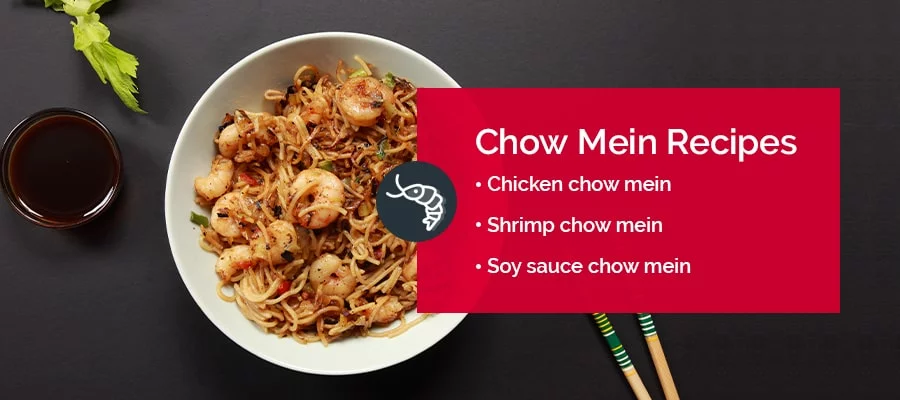
Try one of these classic chow mein recipes for a more exact list of ingredients:
- An iconic Chinese takeaway dish is chicken chow mein. By following the above chow mein instructions and substituting chicken, shredded cabbage, julienned carrots, and green onions for the add-ins, you can quickly prepare your own chicken chow mein.
- Have a seafood enthusiast in your home? If so, shrimp chow mein is sure to become a new dinnertime favorite for anyone who appreciates both seafood and Chinese food. To make this tasty dish, just toss some shrimp, cabbage, carrots, and bean sprouts with your chow mein noodles.
- Simple soy sauce chow mein: A delicious combination of light soy sauce, dark soy sauce, oyster sauce, sesame oil, sugar, white pepper, and Shaoxing wine complements plain fried egg noodles. Ready to show off your chow mein sauce-making prowess?
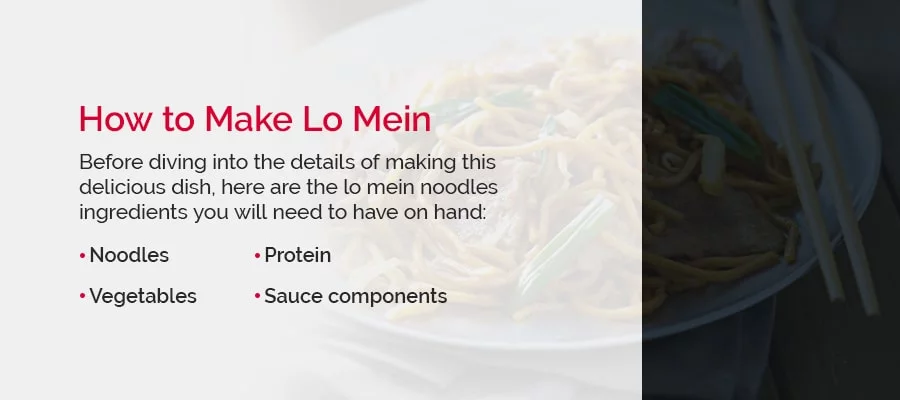
Chow Mein vs. Lo Mein Noodles
You’re not alone if you mistakenly think that chow mein means lo mein and vice versa. When you see the word “mein,” it’s simple to think of them as the same dish. But since “mein” just means “noodles,” confusing chow mein with lo mein is like confusing tortellini with ravioli because both culinary terms refer to a different kind of Italian pasta.
Lo mein is the equivalent of “tossed or stirred noodles” in English, while chow mein is the word for fried noodles. Since noodles are a common ingredient in both dishes, the preparation of the noodles is the primary distinction between chow mein and lo mein. The primary distinctions between each Chinese noodle dish’s preparation styles are as follows:
- The cooking technique: Chow mein and lo mein are prepared entirely differently, even though both recipes use similar ingredients. Before being stir-fried, chow mein noodles are soaked in hot water to soften them. Stir-frying ensures that the noodles and other ingredients are cooked through. Lo mein noodles, on the other hand, are fully cooked before being combined with the meat, veggies, and sauce. The ingredients for lo mein are tossed and gently mixed rather than stir-fried.
- The wok method: Although using a wok yields the best results for both noodle dishes, there are differences in how they should be cooked in the wok. Chow mein noodles are made by quickly stirring ingredients in a wok that has been heated to a very low temperature with a tiny amount of oil. Instead of being fried, the noodles in lo mein are already cooked and are simply combined and tossed with the remaining ingredients.
- The sauce: If there is any sauce at all, chow mein is more of a dry noodle dish with a very light and delicate sauce. The flavor of the saucy noodle dish lo mein is mostly derived from a rich sauce.
- The texture: Because of how they are cooked, chow mein noodles have a tendency to be crunchier than lo mein noodles. Because lo mein noodles are cooked all the way through before being combined with additional ingredients and sauce, they tend to be smoother and slightly chewier. Additionally, the noodles in a lo mein dish need to be thick and resilient enough to hold up the weight of additional sauce.
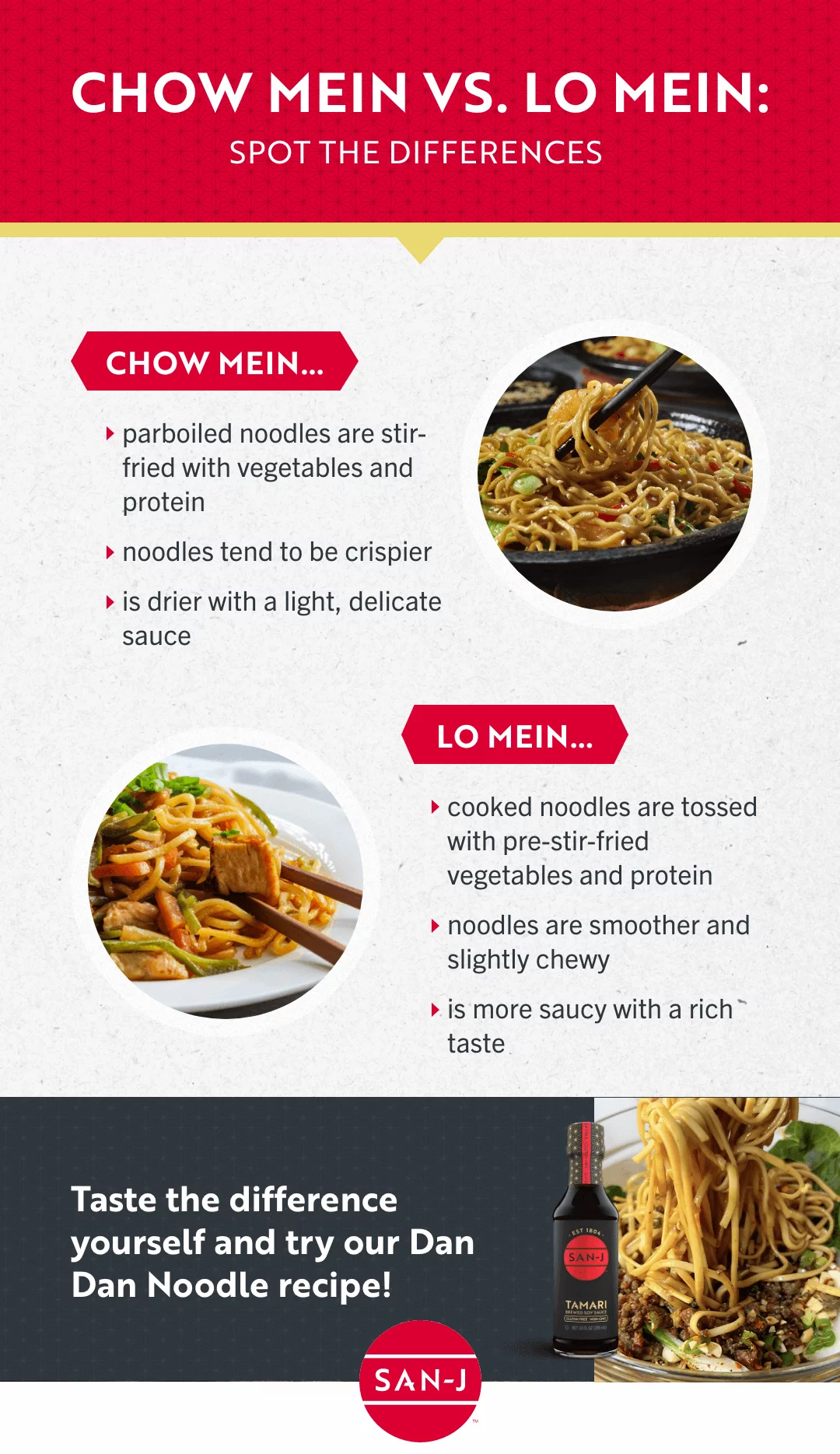
Though they differ, Chinese egg noodles—wheat flour noodles with egg added—are used in both chow mein and lo mein recipes. Chow mein can be made with either fresh or dried egg noodles, but lo mein needs fresh egg noodles.
You must soften the noodles in boiling water before cooking them, whether you use dried or fresh egg noodles. Boiling the egg noodles is intended to soften them just enough without making them overly soft. In Italian cooking, this texture is commonly referred to as “al dente,” which means “cooked to the tooth.” ”.
While dried egg noodles must be parboiled in boiling water for approximately five minutes before they are ready to be cooked with, fresh egg noodles only need to be boiled for a few minutes. Remember that the precise duration of cooking will differ based on the thickness of the noodles, so make sure to adhere to the directions on the package for each type of noodle.
Use linguine noodles, regular Italian spaghetti noodles, or another type of Asian noodle as a comparable alternative if you can’t find noodles that are labeled as chow mein noodles or lo mein noodles.
